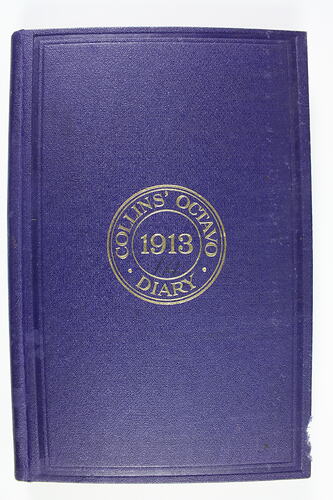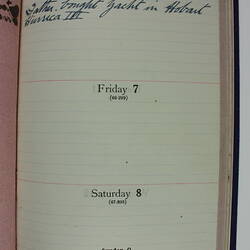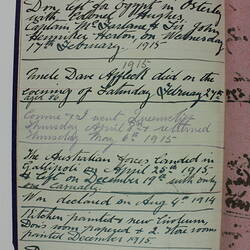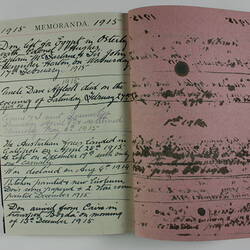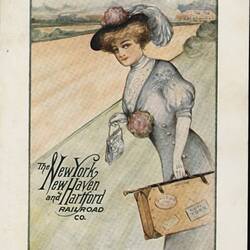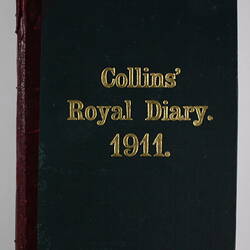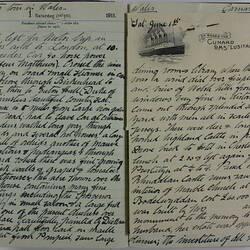Summary
Diary spanning parts of 1913, written by 34 year old Melbourne woman Miss Olive Oliver.
Olive was a wealthy woman. She was born in Armadale, Melbourne in 1879 and died there in 1961. She did not marry or have any children.
This is one of two diaries written by Miss Olive Oliver held by Museum Victoria. This diary has few entries. One refers to Olive's father buying a yacht in Hobart in March 1913, while other later entries in 1915 comment on the declaration of World War I, as well as noting household duties and general family news.
Another, earlier and more comprehensive, diary (see HT 24987) and about eighty travel brochures, maps, railway timetables, postcards and guidebooks that were collected by Miss Olive Oliver during her round-the-world tour of the United States of America, Britain and Europe in 1911, are also held by Museum Victoria.
Physical Description
Small A5 paper diary with handwritten entries.
Significance
Olive Oliver Collection - The sea chest, diaries, travel brochures, guidebooks, maps, postcards and other ephemera in this small collection document Miss Olive Oliver's international travel experience as a wealthy, unmarried Australian woman in the early 20th century, and taps into issues of gender and national identity.
During the first few decades of the 20th century, the world was opening up to the independent or 'New Woman', with many women being granted new economic and legal rights. There were unheralded opportunities for travel and recreation, as well as work, particularly for middle- and upper- class women. In light of this, the collection in general highlights the types of recreational activities popular at the time for wealthy women tourists, such as shopping, socialising, dining and sightseeing. In particular, Olive Oliver's diary also provides fascinating insights into her own particular holiday choices and experiences, and her selection of ephemera souvenirs evocatively highlights her itinerary. The changing role of women in society is evident in the key role that women play in the graphic design of the travel ephemera and postcards in this collection, as well as in the content of some of it. For instance, Miss Oliver was tapping into contemporary popular culture relating to women's emancipation as she travelled around the world. This is particularly evident in some of the postcards that she collected featuring women at work at a major insurance company in New York.
More than just an insight into women's travel and a record of one particular person's holiday, however, the collection is also a signifier of place and national identity in early 20th century Australia. Being located a long way from much of the rest of the world, Australians have long had an interest in travel outside their own national and state borders, and this collection is a reminder of this interest. The collection highlights the importance of travel in the lives of Australians who had immigrated from places such as Britain and Europe. Although Australia's own local tourism industry was expanding in the early 20th century, there was still a strong lure to return 'home' to the 'old world'. There was also a strongly held attraction for the 'grand tour' to Britain and Europe, and trips to new world countries such as America, to expand the cultural education of Australians. The emphasis on travel to countries from which new Australian settlers were traditionally drawn highlights the cultural outlook and identity that Australians engaged with at this time, which was typically British and Eurocentric. This outlook and world-view has persisted from the days of settlement through to recent decades, when it shifted somewhat as interest in travel to our Asian neighbours developed and the origins of immigrants became broader.
Finally, the survival of this collection for almost a century until its acquisition by the Museum highlights the importance that this international tour had in Miss Oliver's life, and the collection will be a remarkable resource for better understanding early 20th century travel.
More Information
-
Collection Names
-
Collecting Areas
-
Acquisition Information
Donation from Lois Comeadow, Dec 2009
-
User
Miss Olive Oliver, Armadale, Greater Melbourne, Victoria, Australia, circa 1913
There are few entries in this diary and although it was produced for the year 1913 it appears not all entries were related to this year. Some were written in 1915. -
Inscriptions
Inscription - front, embossed, gold: ''Collins' Octavo Diary / 1913.'
-
Classification
-
Category
-
Discipline
-
Type of item
-
Overall Dimensions
134 mm (Width), 19 mm (Depth), 204 mm (Height)
-
References
State Library of Victoria, [Link 1]*&CNT=15, accessed 16/07/09 Southern Pacific Historical and Technical Society, [Link 2] accessed 16/07/09 Australian National Maritime Museum, [Link 3] accessed 16/07/09 Family News and Research Data, Oliver Society, Issue No. 21, 2005, p.14 Emails from the donor. [Link 4]
-
Keywords
